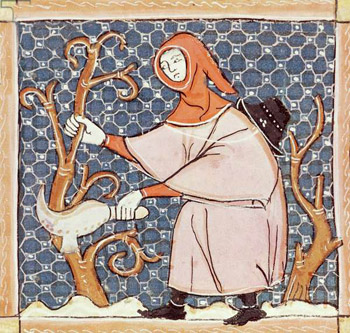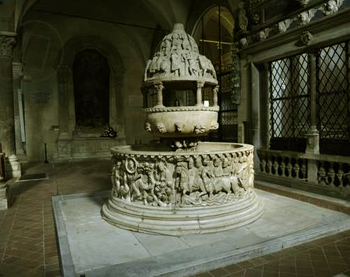Traditionalist Issues
 |
 |
 |
 |
 |
 |
 |
Dialogue Mass - LXX
Vigil of Pentecost Suppressed in 1956 Reform
The ravaging of the liturgical patrimony of the Roman Rite under Pius XII was not confined to the reform of Holy Week but, as the 1948 Commission had planned, (1) extended into other areas of the liturgy as well.
 It is still commonly believed that when the Decree Cum nostra hac aetate of March 23, 1955, purged about half of all the vigils in the Roman Calendar, the Vigil of Pentecost was “spared.” But that would be only a half-truth, for, as we shall see, it was suppressed, cast aside and, then, forgotten within the space of one generation.
It is still commonly believed that when the Decree Cum nostra hac aetate of March 23, 1955, purged about half of all the vigils in the Roman Calendar, the Vigil of Pentecost was “spared.” But that would be only a half-truth, for, as we shall see, it was suppressed, cast aside and, then, forgotten within the space of one generation.
All that was left virtually intact was the Vigil Mass which, in an Orwellian feat, retained its historic title in the Calendar, so that future generations would not realize what exactly they had lost.
And so it came to pass, with the not-too-unpredictable result that traditionalists today are generally unaware that while their 1962 liturgy is still formally called the Vigil of Pentecost, it has not much left in it that is traditional.
Here we will be considering the fate of the Vigil of Pentecost in the 1956 reforms, but first a few pertinent facts are needed to provide a background picture of the kind of thinking that gave rise to this particular reform.
No sound reason for suppression
When the Commission appointed by Pius XII in 1948 drew up plans for the general reform of the liturgy, it decided to jettison most of the Church’s Vigils and Octaves without, as it turns out, any reasonable justification for such radical surgery.
The official reason given by the Congregation of Rites in its decree of March 23, 1955, was for the sake of “simplification.” But, the underlying motivation for the excision of Vigils was revealed in the Commission’s “Memo” to be the reformers’ lack of appreciation and even hatred of the traditional liturgy: Bugnini and his colleagues wanted rid of them on the following pretext:
“In sum, the institution of vigils gradually lost its authentic character and became a type of lifeless liturgical formality.” (2)
This biased and unwarranted assumption became the driving force of the Commission’s determination to suppress most of the Church’s ancient Vigils. The progressivist reformers considered that, just as dead wood has to be cut away to save the plant, “simplification,” i.e., excision, was deemed necessary to obviate the “harm” that the “lifeless” traditional rites can do to the common good.
Fr. Antonelli, who was one of the Commission’s most influential members, gave a more detailed explanation of the 1955 decree:
 “Actually the true purpose of the much-desired simplification of the rubrics is not at all, as some may have thought, to reduce the public prayer of the Church to more limited dimensions. It is rather to free it from all those formalistic and complicated elements, usually of late origin, which have become a burden to the ‘sacrifice of praise’ and have gradually changed the original sobriety of its structure.
“Actually the true purpose of the much-desired simplification of the rubrics is not at all, as some may have thought, to reduce the public prayer of the Church to more limited dimensions. It is rather to free it from all those formalistic and complicated elements, usually of late origin, which have become a burden to the ‘sacrifice of praise’ and have gradually changed the original sobriety of its structure.
“In practice, these formalistic complications have become an annoyance and a hindrance to that living participation, which the whole liturgy of its nature demands. Thus, the purpose in eliminating them is not to pray less but to pray better. That is the spirit of the decree.” (3) [Emphasis added]
But, what sort of reform presumes that all “formalistic and complicated” structures are unauthentic and “lifeless”? Here is the clearest possible indication that the Commission condemned the traditional rites on the assumption that they were not only ineffective and unproductive, but also positively harmful, an obstacle to true participation (and hence to the reception of the graces necessary for salvation).
Could any greater calumny or unjust reproach be conceived against the traditional Roman liturgy, described by Cardinal Ottaviani as “the most complete monument of the Faith,” which for centuries has nourished the souls of countless Catholics and produced an abundance of Saints?
In their deprecation of the traditional rites, the progressivists failed to appreciate that the purpose of having rigid formulas and complex rubrics was, as Cardinal Ottaviani pointed out, to act as “theological ramparts erected for the protection of the rite” and as a “formidable barrier against heresy,” in order to ensure stability of doctrine down the centuries.
As subsequent developments have shown, the razing of these bastions of orthodoxy gave rise to many deviations in the lex orandi, chief among them the Novus Ordo, which led the people away from the true Faith.
The traditional Vigil
From the earliest centuries of the Church, Pentecost had a Baptismal Vigil similar in form to that of Easter. We can see evidence of the baptismal character of these rites in the liturgies of the early Sacramentaries, which record how the Vigil was celebrated as far back as the 7th century and earlier. (4)
When Pope St Pius V codified the Roman Missal in 1570, the Vigil of Pentecost contained texts and ceremonies handed down from previous centuries, including the following:

The traditional Pentecost Vigil, therefore, had a specific purpose and design: to commemorate the beginning of the Church’s saving mission in the world when the Apostles added about 3,000 souls to the Church at Pentecost through the means of Baptism. (Acts 2:41) To eliminate these rituals is to destroy the very identity of the Pentecost Vigil and its historic connection to Holy Saturday.
We can regard the two great Baptismal Vigils – of Easter and Pentecost – as two almost identical ornamental bookends on a shelf enclosing the 50 days of the Easter Season. Together, they formed an artistically balanced showcase to highlight the splendor of one of the most important seasons of the Church’s Liturgical Year.
Wanton vandalism
But Bugnini, like the proverbial bull in a china shop, damaged the first and smashed to smithereens the second of these beautifully crafted ornaments.
 The venerable texts and rituals of the Vigil of Pentecost were doomed to extinction by the 1948 Liturgical Commission. Asked whether it would be appropriate to abolish these ceremonies, all three consultors – Jungmann, Capelle and Righetti – agreed unanimously that they should be excised. (5)
The venerable texts and rituals of the Vigil of Pentecost were doomed to extinction by the 1948 Liturgical Commission. Asked whether it would be appropriate to abolish these ceremonies, all three consultors – Jungmann, Capelle and Righetti – agreed unanimously that they should be excised. (5)
And so, the axe of the Commission’s arbitrary liturgical standards was once more swung against the Church’s ancient traditions. As early as 1952, all of these ceremonies of the Vigil of Pentecost were prohibited in any church where the experimental Easter Vigil was celebrated. Then, in 1956, they were universally suppressed, with the approval of Pius XII, for the entire Roman Rite.
In the next section, we will examine closely the “fallout” of this reform as it manifested itself in the 1962 Missal.
Continued


The Vigil of Pentecost was cut from the liturgy in the 1956 Reform
All that was left virtually intact was the Vigil Mass which, in an Orwellian feat, retained its historic title in the Calendar, so that future generations would not realize what exactly they had lost.
And so it came to pass, with the not-too-unpredictable result that traditionalists today are generally unaware that while their 1962 liturgy is still formally called the Vigil of Pentecost, it has not much left in it that is traditional.
Here we will be considering the fate of the Vigil of Pentecost in the 1956 reforms, but first a few pertinent facts are needed to provide a background picture of the kind of thinking that gave rise to this particular reform.
No sound reason for suppression
When the Commission appointed by Pius XII in 1948 drew up plans for the general reform of the liturgy, it decided to jettison most of the Church’s Vigils and Octaves without, as it turns out, any reasonable justification for such radical surgery.
The official reason given by the Congregation of Rites in its decree of March 23, 1955, was for the sake of “simplification.” But, the underlying motivation for the excision of Vigils was revealed in the Commission’s “Memo” to be the reformers’ lack of appreciation and even hatred of the traditional liturgy: Bugnini and his colleagues wanted rid of them on the following pretext:
“In sum, the institution of vigils gradually lost its authentic character and became a type of lifeless liturgical formality.” (2)
This biased and unwarranted assumption became the driving force of the Commission’s determination to suppress most of the Church’s ancient Vigils. The progressivist reformers considered that, just as dead wood has to be cut away to save the plant, “simplification,” i.e., excision, was deemed necessary to obviate the “harm” that the “lifeless” traditional rites can do to the common good.
Fr. Antonelli, who was one of the Commission’s most influential members, gave a more detailed explanation of the 1955 decree:

Pretending to prune away the "lifeless" wood
“In practice, these formalistic complications have become an annoyance and a hindrance to that living participation, which the whole liturgy of its nature demands. Thus, the purpose in eliminating them is not to pray less but to pray better. That is the spirit of the decree.” (3) [Emphasis added]
But, what sort of reform presumes that all “formalistic and complicated” structures are unauthentic and “lifeless”? Here is the clearest possible indication that the Commission condemned the traditional rites on the assumption that they were not only ineffective and unproductive, but also positively harmful, an obstacle to true participation (and hence to the reception of the graces necessary for salvation).
Could any greater calumny or unjust reproach be conceived against the traditional Roman liturgy, described by Cardinal Ottaviani as “the most complete monument of the Faith,” which for centuries has nourished the souls of countless Catholics and produced an abundance of Saints?
In their deprecation of the traditional rites, the progressivists failed to appreciate that the purpose of having rigid formulas and complex rubrics was, as Cardinal Ottaviani pointed out, to act as “theological ramparts erected for the protection of the rite” and as a “formidable barrier against heresy,” in order to ensure stability of doctrine down the centuries.
As subsequent developments have shown, the razing of these bastions of orthodoxy gave rise to many deviations in the lex orandi, chief among them the Novus Ordo, which led the people away from the true Faith.
The traditional Vigil
From the earliest centuries of the Church, Pentecost had a Baptismal Vigil similar in form to that of Easter. We can see evidence of the baptismal character of these rites in the liturgies of the early Sacramentaries, which record how the Vigil was celebrated as far back as the 7th century and earlier. (4)
When Pope St Pius V codified the Roman Missal in 1570, the Vigil of Pentecost contained texts and ceremonies handed down from previous centuries, including the following:

A 12th century Baptism font in San Frediono Basilica, Lucca, Italy
- 6 readings from the Old Testament (Prophecies) and 3 Tracts, all taken from Holy Saturday;
- 6 Collects on the theme of Baptism;
- Recitation of the Prophecies by the priest while another minister chanted them;
- Procession of the clergy to the font;
- Blessing of the font;
- Administration of Baptism;
- Singing of the Litany of the Saints;
- Use of folded chasubles before the celebration of the Vigil Mass.
The traditional Pentecost Vigil, therefore, had a specific purpose and design: to commemorate the beginning of the Church’s saving mission in the world when the Apostles added about 3,000 souls to the Church at Pentecost through the means of Baptism. (Acts 2:41) To eliminate these rituals is to destroy the very identity of the Pentecost Vigil and its historic connection to Holy Saturday.
We can regard the two great Baptismal Vigils – of Easter and Pentecost – as two almost identical ornamental bookends on a shelf enclosing the 50 days of the Easter Season. Together, they formed an artistically balanced showcase to highlight the splendor of one of the most important seasons of the Church’s Liturgical Year.
Wanton vandalism
But Bugnini, like the proverbial bull in a china shop, damaged the first and smashed to smithereens the second of these beautifully crafted ornaments.

The progressivists razed the ramparts of orthodoxy that had protected the Church's rites for centuries
And so, the axe of the Commission’s arbitrary liturgical standards was once more swung against the Church’s ancient traditions. As early as 1952, all of these ceremonies of the Vigil of Pentecost were prohibited in any church where the experimental Easter Vigil was celebrated. Then, in 1956, they were universally suppressed, with the approval of Pius XII, for the entire Roman Rite.
In the next section, we will examine closely the “fallout” of this reform as it manifested itself in the 1962 Missal.
Continued
- The minutes of all the meetings that the Commission held from its inception to 1960 when it was absorbed into the Central Preparatory Commission are reproduced as an appendix in N. Glampietro, Il Card. Ferdinando Antonelli e gli sviluppi della riforma liturgica dal 1948-1970, Rome: Pontificio Ateneo S. Anselmo, 1998, pp. 278-388.
- See Carlo Braga, ed., La Riforma Liturgica di Pio XII: Documenti: I. La Memoria sulla Riforma Liturgica, 1948, Rome: Edizioni Liturgiche, 2003, n. 117.
- F. Antonelli, from the Preface to A. Bugnini, The Simplification of the Rubrics, trans. L.J. Doyle, Collegeville, MN: Doyle and Finegan, 1955, p. 7.
- See the 7th century Gelasian Sacramentary, Liber Sacramentorum Romanae Ecclesiae, pp. 110 ff.
- Memoria, Supplement II, 1950, n. 80, p. 79.

Posted May 21, 2018
______________________
______________________
 Volume I |
 Volume II |
 Volume III |
 Volume IV |
 Volume V |
 Volume VI |
 Volume VII |
 Volume VIII |
 Volume IX |
 Volume X |
 Volume XI |
 Special Edition |


